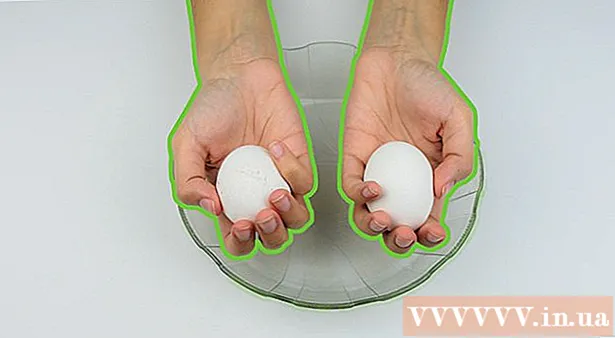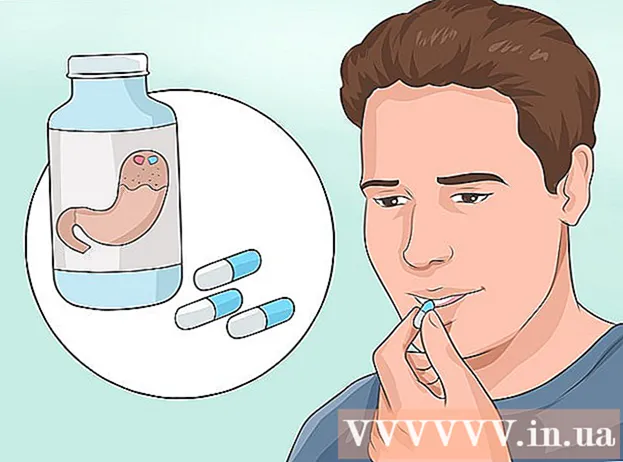Author:
Ellen Moore
Date Of Creation:
12 January 2021
Update Date:
1 July 2024

Content
Guinea pig foods sold at pet stores as treats for your pets often contain more fat, sugar, and other harmful ingredients than are safe for your guinea pig's health. Manufacturers sometimes add foods that are not suitable for the digestion of pigs, such as yogurt, to their food. Keep in mind that guinea pigs have different tastes and nutritional needs than humans, and these little pets will love this simple and nutritious treat made with fruits and vegetables.
Steps
Method 1 of 2: Making a Healthy Treat
 1 Choose raw, nutritious vegetables. Guinea pigs should get fresh vegetables every day, but since vegetables are the animals' favorite food, it will make your pet more joyful if you offer him a large serving at once as a treat every few days or once a week.Take vegetables that are already familiar to your pets and are part of their daily diet, and add new vegetables in small amounts at first, gradually increasing it to avoid digestive problems.
1 Choose raw, nutritious vegetables. Guinea pigs should get fresh vegetables every day, but since vegetables are the animals' favorite food, it will make your pet more joyful if you offer him a large serving at once as a treat every few days or once a week.Take vegetables that are already familiar to your pets and are part of their daily diet, and add new vegetables in small amounts at first, gradually increasing it to avoid digestive problems. - Romaine lettuce, bib lettuce, and red lettuce are ideal for preparing feed. Avoid iceberg lettuce and other juicy lettuces that are lower in nutrients and can cause digestive problems.
- Red bell peppers and tomatoes, from which the stalks and seeds have been removed, work well. Seeds may not be removed from small tomatoes, but the stalks may contain toxic substances.
- Carrots, corn and celery can be added to feed along with herbs.
- Most vegetables can be used safely, but be sure to read the "foods to avoid" section first or consult your veterinarian.
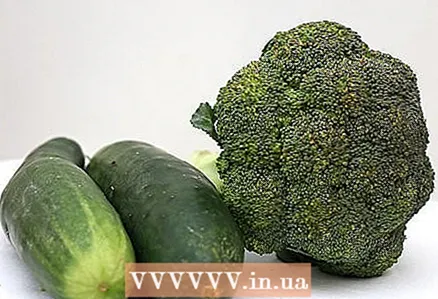 2 You can use the rest of the vegetables, but add them in small amounts. Like humans, guinea pigs love variety. They eat vegetables from a plate containing small pieces of different vegetables with great appetite, even if your pets eat these foods on a daily basis. While you can use the vegetables listed above to treat your guinea pigs, some vegetables should only be added to your guinea pigs in small amounts. and not included in the regular diet of pets:
2 You can use the rest of the vegetables, but add them in small amounts. Like humans, guinea pigs love variety. They eat vegetables from a plate containing small pieces of different vegetables with great appetite, even if your pets eat these foods on a daily basis. While you can use the vegetables listed above to treat your guinea pigs, some vegetables should only be added to your guinea pigs in small amounts. and not included in the regular diet of pets: - Although low in nutrients, cucumbers are essential for guinea pigs to maintain normal tooth length. In addition, these vegetables allow the guinea pigs to get extra water on hot days.
- White cabbage, kale, cabbage, cauliflower and broccoli can only be given to guinea pigs in small quantities. Adding large amounts of these vegetables to food can cause gas in the intestines and bloating in your pets.
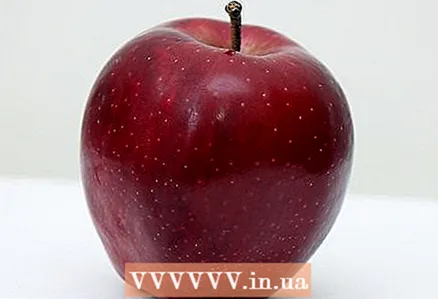 3 Add some fruit (optional). Fruits are rich in acids and sugars, and guinea pigs generally enjoy eating vegetables rather than fruits, although the individual tastes of different guinea pigs may differ. A small amount of fruit added to the vegetable mixture can provide the extra vitamin C that your pets need to keep healthy. We suggest you add one of the following products:
3 Add some fruit (optional). Fruits are rich in acids and sugars, and guinea pigs generally enjoy eating vegetables rather than fruits, although the individual tastes of different guinea pigs may differ. A small amount of fruit added to the vegetable mixture can provide the extra vitamin C that your pets need to keep healthy. We suggest you add one of the following products: - A small slice of apple or pear that has been removed from the seeds and core.
- or one or two slices of orange, tangerine, or other not very acidic citrus. Sour citrus fruits such as grapefruit can be left uneaten due to their sour taste.
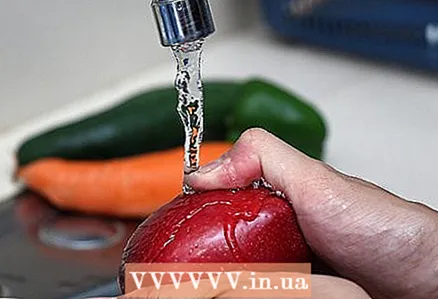 4 Rinse all fruit thoroughly. Rinse vegetables and fruits under running water to remove bacteria, pesticides and other harmful substances that may be on the surface. For the safety of your pets, be sure to wash even those vegetables and fruits that you have grown in your garden, because dust and harmful substances from the air can settle on the surface of vegetables.
4 Rinse all fruit thoroughly. Rinse vegetables and fruits under running water to remove bacteria, pesticides and other harmful substances that may be on the surface. For the safety of your pets, be sure to wash even those vegetables and fruits that you have grown in your garden, because dust and harmful substances from the air can settle on the surface of vegetables.  5 Cut vegetables and fruits into pieces that are easy to eat. Cut your pet treat vegetables into small pieces that are suitable for animal feed. This is especially important for vegetables that are high in fiber, such as celery, because guinea pigs will find it difficult to separate such foods into easy-to-eat portions on their own.
5 Cut vegetables and fruits into pieces that are easy to eat. Cut your pet treat vegetables into small pieces that are suitable for animal feed. This is especially important for vegetables that are high in fiber, such as celery, because guinea pigs will find it difficult to separate such foods into easy-to-eat portions on their own. 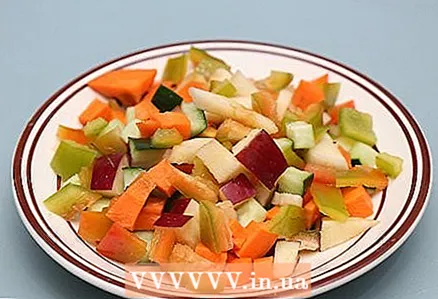 6 We recommend giving treats to pigs without pre-cooking the food. Boiling food destroys many vitamins and nutrients, so it is best to feed your guinea pigs raw vegetables and fruits. In addition, cooking softens vegetables and fruits, and guinea pigs need solid food that allows them to grind down growing teeth and maintain their length at the desired level. If the guinea pig does not get enough solid food, their teeth become too long, and because of this, the guinea pig cannot eat normally, and they may even suffer damage to the jaws and head.
6 We recommend giving treats to pigs without pre-cooking the food. Boiling food destroys many vitamins and nutrients, so it is best to feed your guinea pigs raw vegetables and fruits. In addition, cooking softens vegetables and fruits, and guinea pigs need solid food that allows them to grind down growing teeth and maintain their length at the desired level. If the guinea pig does not get enough solid food, their teeth become too long, and because of this, the guinea pig cannot eat normally, and they may even suffer damage to the jaws and head.  7 If you plan on storing the gilts' treat for a while, you will need to grind the food and bake it in the oven. If you plan to cook a lot of food at once and store it for a while, you need to chop the vegetables and fruits to a puree state and mix with regular pig food (hay or pelleted food) so that the resulting thick puree takes up less volume. This will make your product easier to transport. To harden the food and extend its shelf life, spread the mixture between two sheets of cling film, place in the freezer for 20 minutes, and then bake in the oven at 180ºC or less for 20 minutes or until the mixture will not harden.
7 If you plan on storing the gilts' treat for a while, you will need to grind the food and bake it in the oven. If you plan to cook a lot of food at once and store it for a while, you need to chop the vegetables and fruits to a puree state and mix with regular pig food (hay or pelleted food) so that the resulting thick puree takes up less volume. This will make your product easier to transport. To harden the food and extend its shelf life, spread the mixture between two sheets of cling film, place in the freezer for 20 minutes, and then bake in the oven at 180ºC or less for 20 minutes or until the mixture will not harden. - Choose for these purposes quality brands of pellets that are appropriate for the age and condition of your pets. A treat made with a mixture of pellets and fresh vegetables and fruits is much more economical than a meal made with only fresh ingredients.
- If your treat is firm enough, you can use cookie cutters to cut interesting shapes out of it.
Method 2 of 2: Foods to Avoid
 1 Never feed your guinea pigs with meat or dairy products. Guinea pigs are herbivores, which means they can only digest plant foods. Meat and dairy products contain animal protein that guinea pigs cannot digest.
1 Never feed your guinea pigs with meat or dairy products. Guinea pigs are herbivores, which means they can only digest plant foods. Meat and dairy products contain animal protein that guinea pigs cannot digest.  2 Try not to give your guinea pigs nuts or seeds. Although guinea pigs love this food, small spicy bits of food can damage the digestive system or cause choking. A small amount of crushed seeds added to food will not harm you, but if in doubt, don't risk it. Never add husked seeds, such as sunflower seeds, to your food.
2 Try not to give your guinea pigs nuts or seeds. Although guinea pigs love this food, small spicy bits of food can damage the digestive system or cause choking. A small amount of crushed seeds added to food will not harm you, but if in doubt, don't risk it. Never add husked seeds, such as sunflower seeds, to your food. 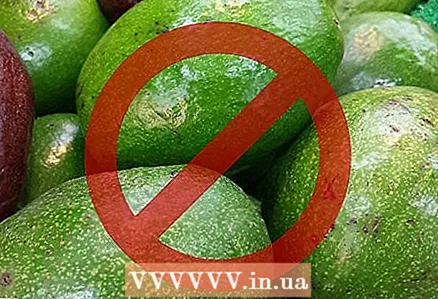 3 Do not add avocado or coconut to guinea pigs. They are too high in fat to benefit your pet's health. More importantly, avocados can be toxic to many pets, causing health problems or even death.
3 Do not add avocado or coconut to guinea pigs. They are too high in fat to benefit your pet's health. More importantly, avocados can be toxic to many pets, causing health problems or even death.  4 Eliminate iceberg lettuce and potatoes from your pet's diet. These vegetables cause indigestion and are low in nutrients. Almost all vegetables except these are safe for gilts as a treat, always add small amounts of new food first to avoid possible digestive problems.
4 Eliminate iceberg lettuce and potatoes from your pet's diet. These vegetables cause indigestion and are low in nutrients. Almost all vegetables except these are safe for gilts as a treat, always add small amounts of new food first to avoid possible digestive problems. 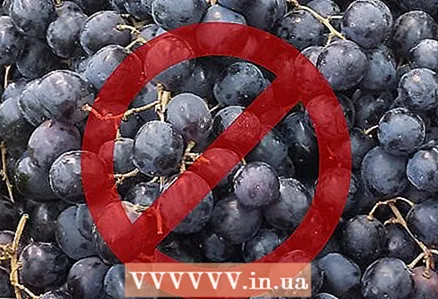 5 Avoid giving rhubarb and grapes to guinea pigs. Rhubarb causes digestive problems in these animals. Some veterinarians believe that grapes, especially grapes with seeds, can cause kidney disease in guinea pigs. Although the risk of kidney damage due to grape consumption has not been proven, it is best not to add grapes to your food and choose safer fruits.
5 Avoid giving rhubarb and grapes to guinea pigs. Rhubarb causes digestive problems in these animals. Some veterinarians believe that grapes, especially grapes with seeds, can cause kidney disease in guinea pigs. Although the risk of kidney damage due to grape consumption has not been proven, it is best not to add grapes to your food and choose safer fruits. - Fruit should be added to food infrequently, in small quantities.
 6 Don't give your guinea pigs multivitamins. The only vitamin. what guinea pigs need is vitamin C. Multivitamins contain many other vitamins in quantities that can cause serious health problems for your pets. It is best to give your guinea pigs only vitamin C by adding a little cranberry juice or liquid vitamin C to the food.
6 Don't give your guinea pigs multivitamins. The only vitamin. what guinea pigs need is vitamin C. Multivitamins contain many other vitamins in quantities that can cause serious health problems for your pets. It is best to give your guinea pigs only vitamin C by adding a little cranberry juice or liquid vitamin C to the food. - If your guinea pigs begin to drink less liquid due to the taste of added juice or drips, you should not continue to add vitamin C to food. It is better to feed the pigs with vitamin C-fortified pellets or increase the amount of vegetables such as bell peppers or squash in the diet.
 7 Never feed your guinea pigs food from your table. Stick to the vegetables and fruits recommended in this article, or follow the advice of your veterinarian. Feeding your gilts with food from your table can adversely affect your pet's health. Chocolate, baked goods, alcohol and coffee are especially harmful to the health of pigs.
7 Never feed your guinea pigs food from your table. Stick to the vegetables and fruits recommended in this article, or follow the advice of your veterinarian. Feeding your gilts with food from your table can adversely affect your pet's health. Chocolate, baked goods, alcohol and coffee are especially harmful to the health of pigs.
Tips
- Your guinea pigs will love it when you treat them to an assortment of different vegetables.
Warnings
- Always start with a small amount of a new product, you don't know if your pig will like it.
